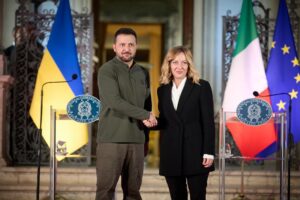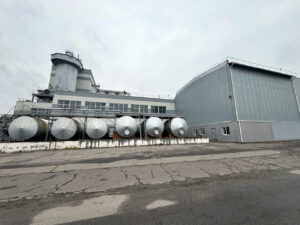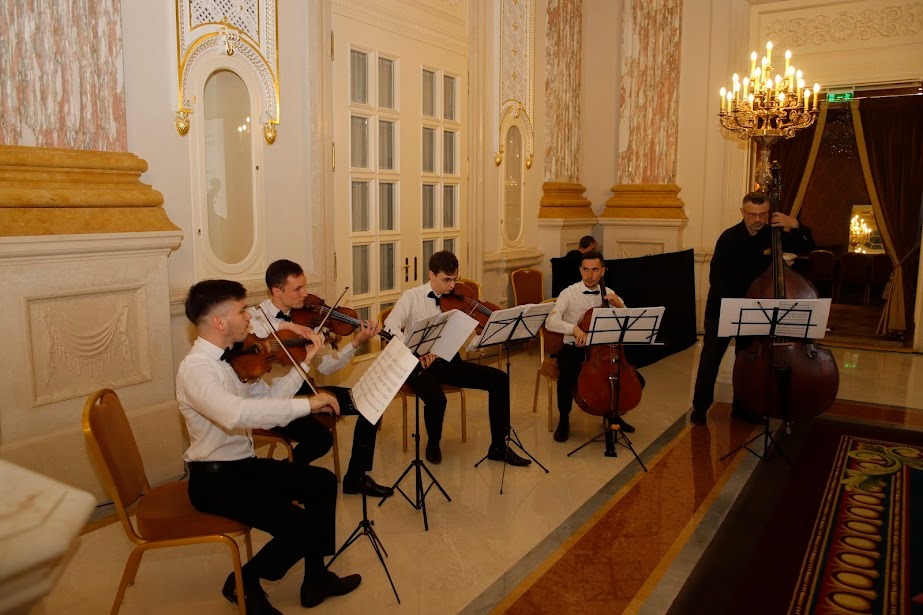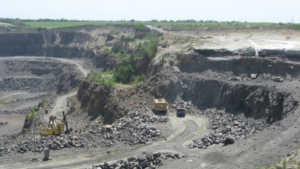
Italy is interested in investing in Ukraine and is ready to invest resources without delay, sign agreements, and provide financial guarantee instruments for companies that plan to invest in Ukraine’s reconstruction measures, Italian Prime Minister Giorgia Meloni says.
“Italy, as a country, is also ready to contribute and start now and rebuild what was destroyed – roads, bridges, hospitals, all these buildings,” Meloni said at the Ukraine Recovery Conference (URC2025) during a joint statement with Ukrainian President Volodymyr Zelensky to reporters in Rome on Thursday.
She noted that Italy has already taken Odessa under its patronage to restore cultural and heritage objects. “And we want to even go further, we want to expand our contribution: this is energy, critical infrastructure, transportation, agriculture, also health care. Of course, I won’t list all the initiatives now, but I want to remind you that we are doing a lot of things that are symbolic in terms of humanitarian aid,” the head of the Italian government said.
Meloni also noted that Italy will help in the heroic resistance to Ukraine. “We have done it in different senses and we will also do it on industry and also defense sector and cooperation. We have also talked about this, and this is evidenced by a number of agreements signed today, this is a central theme. And, of course, we will continue our investments, because we understand how important it is to do everything possible so that Ukraine can fight, fight back, defend itself,” she said.
According to the Italian Prime Minister, peace in Ukraine should be “long, lasting, just”, in particular through deterrence.

In 1,780 cases of violation of customs rules, the objects of offenses worth almost UAH 370 million were temporarily seized. In particular:
– industrial goods worth UAH 213 million
– vehicles worth over UAH 122 million
– foodstuffs worth over UAH 33 million;
– currency worth UAH 2.2 million.
In 899 cases of customs rules violations, including those initiated in previous periods, customs applied administrative penalties in the form of fines amounting to UAH 31 million, and collected UAH 31 million to the state budget, taking into account cases considered in the previous period. The customs authorities submitted 2,689 cases of customs rules violations worth over UAH 5.5 billion to the courts. As a result of court proceedings, including those initiated in the previous periods, penalties (confiscation of goods and fines) amounted to UAH 2.5 billion.

The State Property Fund has announced an auction for the privatization of a 100% stake in the charter capital of Vinnytsiabytkhim, a private joint-stock company, on August 13, according to the press service of the State Property Fund of Ukraine.
According to the announcement, online bidding will take place in the Prozorro.Prozori electronic trading system with a starting price of UAH 301.4 million. The guarantee deposit is UAH 15.07 million, and the registration fee is UAH 80,000 (all figures are exclusive of VAT). The deadline for submitting bids for participation in the auction is August 12, inclusive (until 8:00 p.m.).
The property is located in Vinnytsia, at 4 Akademika Yangelya Street.
The main activity is the production of soap and detergents, cleaning and polishing products. The authorized capital is UAH 26,636,700.
The property consists of 25 units of real estate (buildings, structures, non-residential premises, etc.) with a total area of 31,364.2 square meters, located on four land plots with a total area of 4.1074 hectares.
PJSC Vinnytsiabychim has not entered into any lease agreements for its property.
According to the announcement, the new owner of the enterprise must maintain the main activities of the company and not allow the dismissal of employees during the first six months.
In addition, it must pay wage arrears and budget debts within six months, repay overdue accounts payable (except for debts to persons subject to sanctions), and comply with environmental legislation.
Vinnytsiabytkhim is included in the list of large privatization objects.
As reported, on July 31, 2024, the High Anti-Corruption Court (HACC) upheld the Ministry of Justice’s claim to impose sanctions on the Russian company Nevskaya Kosmetika in the form of confiscating 100% of the shares of the Ukrainian company Vinnytsiabutkhim to the state.
In July 2022, the seized assets of PJSC Vinnytsiabutkhim were transferred to the National Agency for the Detection, Investigation, and Management of Assets Derived from Corruption and Other Crimes (ARMA).
Following a competitive selection process in July 2023, the right to resume operations and become the asset manager was awarded to Kraitex-Service LLC, whose beneficiaries, according to Opendatabot, are Ruslan Shostak and Valery Kiptik, co-owners of the EVA and Varus chains. Later, Kraitex-Service announced that it would invest UAH 400 million in launching production at Vinnytsiabitim.
ARMA terminated its management of the asset in April 2025 and transferred it to the State Property Fund of Ukraine for further sale. According to the National Agency, during the period of management of the seized asset, almost UAH 100 million was transferred to the state budget.
As previously reported to Interfax-Ukraine by Afina Group, which includes Kraitex-Service LLC, the company is considering participating in a privatization auction for the acquisition of the production assets of PrP Vinnytsiaputkhim, which have been operating in the company’s production chain for the past two years. At the same time, Afina Group will not fight for the assets at any price, as it has a clear understanding of the limits of the feasibility of participating in competitive bidding.
For more information about PrVT Vinnytsiaputkhim, please visit: https://is.gd/VZVnkE

The volume of remittances to Ukraine for January-May 2025 decreased by 15.4% to – $3.5 billion, in particular net remuneration of labor decreased by 18.7%, and the volume of private transfers – by 11.2%, according to the data of the balance of payments of the National Bank of Ukraine (NBU). As noted in the statistics, in May, the volume of private money transfers decreased by 13.2%, to $0.7 billion.
“Wages that Ukrainians receive from abroad decreased by 9.5%, and other private transfers received through official channels decreased by 9.7%,” – commented the National Bank.
Overall, the volume of transfers through official channels in May 2025 was 9.6% lower than in May 2024, while receipts through informal channels decreased by 18% year-on-year.
In May 2025, the primary revenue balance turned negative to $45 million against a surplus of $20 million in May 2024.
“The decline in labor compensation receipts (down 16.9%) was more rapid than the decline in investment income payments6 (down 2.7%).” The secondary income balance surplus shrank,” the regulator explains.
At the same time, the secondary income balance surplus decreased to $0.7bn from $1.0bn in May last year due to a reduction in technical and humanitarian aid.

A solemn diplomatic reception was held in Kyiv on the occasion of the 34th anniversary of the declaration of independence of the Republic of Slovenia. The event brought together representatives of the Ukrainian government, diplomatic corps, the public and businesses operating in Ukraine. The Ambassador Extraordinary and Plenipotentiary of the Republic of Slovenia to Ukraine, Ms. Mateja Prevolšek, delivered a speech.
In her address, the Ambassador emphasized the commonality of the historical challenges that Slovenia and Ukraine have faced in their struggle for independence, democracy and national identity.
“Slovenia is celebrating its 34th birthday. At the same time, Ukraine gained its independence, because it was an era full of changes, new ideas and hopes for freedom, democracy and economic development,” Mateja Prevolšek said.

She emphasized that despite the obvious geographical and demographic differences, the two countries have been maintaining close partnerships for over 30 years. According to her, Slovenia is firmly committed to supporting Ukraine’s European course and its struggle for freedom.
“I have had and have the opportunity to see the courage of the Ukrainian people, their desire for a better future in their own country, visiting many Ukrainian regions, cities and villages to support projects within the framework of Slovenian development cooperation and humanitarian aid,” the diplomat added.
Slovenia supports a number of initiatives in Ukraine, including rehabilitation of veterans, training of psychologists and teachers to work with traumatized children, and cooperation between Ukrainian and Slovenian municipalities.
The guests were especially warm when the Ambassador told them about her personal decision to learn Ukrainian. She emphasized the importance of preserving linguistic identity for both Slovenes and Ukrainians.
“It was a very good decision, because I will not only learn the melodiousness of your language, but I will also be able to communicate with people and better understand their feelings,” Ms. Prevolšek emphasized.
At the end of her speech, the Ambassador expressed her gratitude to all Slovenian companies operating in Ukraine that contributed to the organization of the reception, as well as to the diplomatic team and her husband for their support.
The reception ended with the traditional raising of glasses in honor of the friendship between Slovenia and Ukraine, which, according to the Ambassador, “was born out of a difficult past, but is confidently moving towards a common future.”

During its spring offensive, Russian forces took control of one of Ukraine’s most promising lithium deposits — the Shevchenkivske site in Donetsk region. Previously under development by an American critical minerals company, the site was seen as a key asset in the growing economic partnership between Kyiv and Washington in the field of strategic resources. Its capture now poses serious risks to future joint projects and has already raised concerns among Western investors.
The Shevchenkivske deposit contains significant reserves of spodumene — a mineral from which lithium is extracted. Lithium is essential for manufacturing batteries used in electric vehicles and energy storage systems. Ukraine had earlier signed a framework agreement with the United States on cooperation in the field of critical raw materials, including the development of domestic lithium, titanium, and rare earth element extraction — crucial for the West’s green energy transition. The agreement envisioned attracting investment into Ukrainian subsoil resources. However, with Shevchenkivske now under Russian control, the feasibility of that cooperation is under threat.
Myroslav Zhernov, the director of the company holding the license for the site, confirmed the loss in a comment to The New York Times. According to him, the battle for the deposit lasted several weeks: “It was very hot. They were bombing with everything they had. And now they’re there.” Zhernov warned that this may not be the end: “If the Russians advance farther, they will control more and more deposits.”
The New York Times reports that signs of activity have already been observed on the occupied territory: an assessment of reserves is underway, and preparations for future extraction may be in progress. In this way, control over lithium could give the Kremlin not only military but also geoeconomic advantages. The article notes that Russia is already leveraging its influence in global raw materials supply chains, particularly in uranium markets.
Although Ukraine still possesses two other major lithium deposits in its western regions, Shevchenkivske was considered the most promising due to its high spodumene concentration — up to 90%. In peacetime, the development of this site could have become not only a source of revenue, but a strategic lever for integrating Ukraine into Western critical materials markets.
Former head of the State Service of Geology and Mineral Resources, Roman Opimakh, explained that such investments are subject to enormous risks during wartime: “Security and control over a deposit is the main prerequisite. The military threat scares away investors, and the loss of such a site effectively nullifies any near-term development plans.”
Observers note that the war is increasingly taking on characteristics of economic conflict. Russia is not only destroying infrastructure but is actively targeting resources that could be useful to itself or potentially strengthen Ukraine. Gaining control over lithium assets allows for pressure on Western corporations and contributes to reshaping global dependencies.
Despite the loss, Zhernov said his company is not giving up on investing in Ukraine and is exploring other options. However, he admitted the situation has fundamentally changed risk assessments: “Before, we saw this project as a driver of economic growth. Now — it’s just another front in the war.”
Earlier, the Experts Club information and analysis center produced a detailed video analysis of the prospects for rare earth element mining in Ukraine.